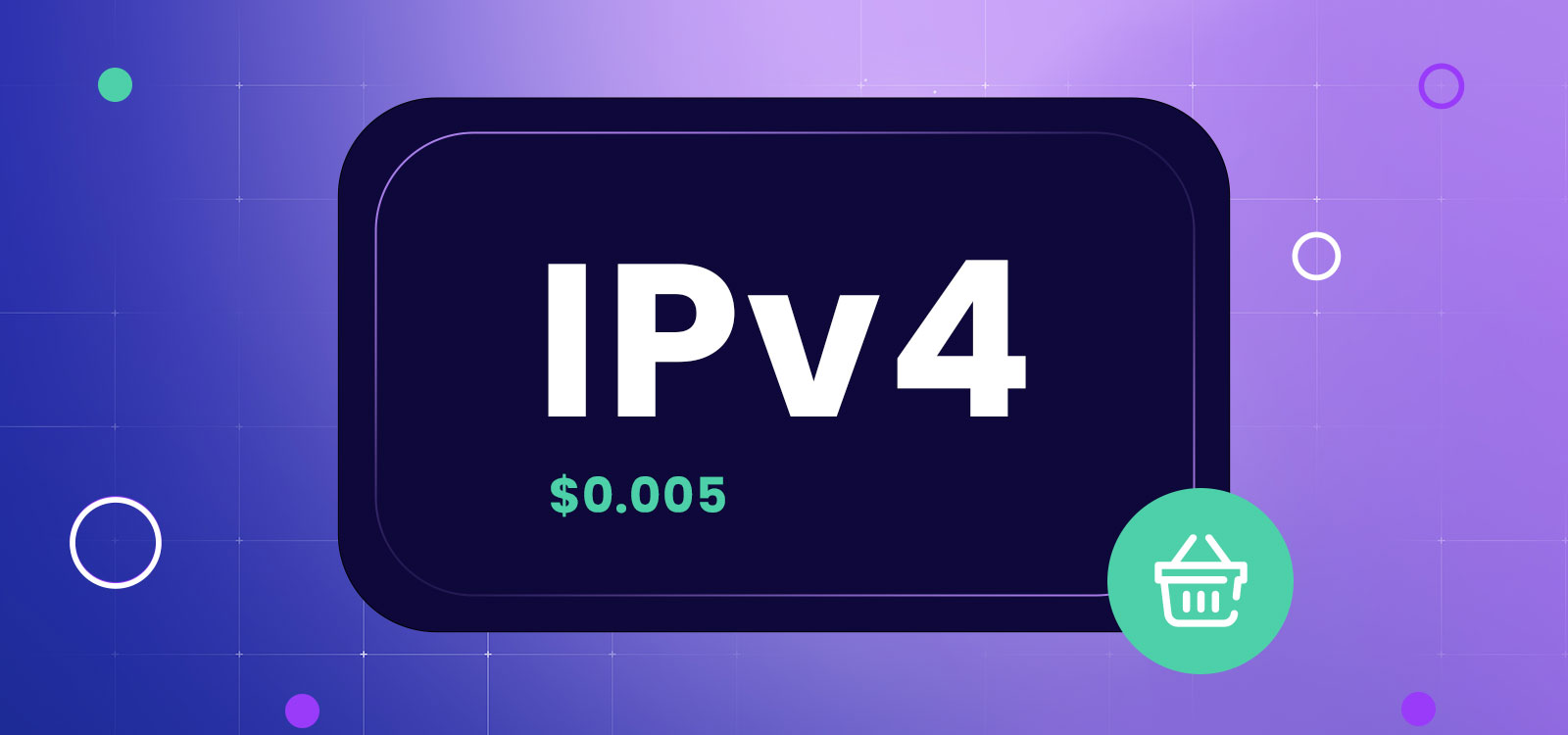


|
||
|
||

In a rapidly evolving digital landscape, the value of IP addresses has surged to the forefront of discussions. Over a month ago, Amazon Web Services (AWS) made a pivotal announcement, reshaping the IP address pricing landscape.
Citing the escalating costs of acquiring IP addresses on secondary markets, AWS declared a fundamental shift in its pricing strategy, set to take effect on February 1, 2024. Under this new pricing model, AWS will charge $0.005 per public IPv4 address per hour, amounting to approximately $43 per year for each address.
The ramifications of this seismic shift in pricing extend beyond AWS and its vast customer base. This change not only holds the potential to impact cloud environments built on public IPs but also has broader implications for responsible IP management, pricing transparency, and the much-needed push toward faster IPv6 adoption.
It signifies a pivotal moment that has effectively set a healthy IP lease rate, and in this opinion piece, we delve deeper into this transformative subject.
To comprehend the significance of AWS’s pricing update, we must first recognize the immense role that Amazon plays in the IPv4 market. Excluding mergers and acquisitions, over 377 million IP resource transfers occurred between 2009 and 2022, with three major players in the cloud hosting industry, namely Google (5%), Microsoft (13%), and Amazon (33.45%), accounting for a staggering 52% of these transfers.
Since 2011, Amazon has been an active participant in the IPv4 transfer market, acquiring over 126 million IPs. Their acquisitions span a wide array of companies and organizations, from DuPont and Xerox to the Massachusetts Institute of Technology, HP, Ford Motor, and AT&T.
In 2022, Amazon solidified its dominance by procuring a substantial 23.2 million IPs, surging far ahead of its competitors. Notably, Amazon’s IP acquisitions more than doubled those of Microsoft and exceeded Google’s by over eightfold, with the latter securing 6.23 million IPs (12.9%) and 4.23 million IPs (8.8%) during the same timeframe.
In essence, these three industry titans jointly wield unparalleled influence over the IP acquisition market. Amidst this backdrop, questions abound regarding the delicate equilibrium between IP acquisition and the subsequent pricing models directed toward customers.
Amazon, in its decisive move, has effectively set a benchmark by stipulating that its acquired IP addresses should command a price of approximately $43 per IPv4 address annually.
The implications of AWS’s pricing change extend beyond the surface. Amazon’s business model charges enterprises based on various factors like requests, resource usage, traffic, and, notably, IP addresses. The new IP pricing aligns logically with their strategy.
Another critical aspect is the valuation of IP resources within the IPv4.Global marketplace, a branch of Hilco Streambank handling IP address transactions. Notably, a /16 block has historically traded at approximately $50, setting a precedent for Amazon’s expectation of IP payback within a year.
Now, let’s examine the broader market impact of AWS’s rate adjustment. While a $43 annual fee per IP may not seem substantial compared to what customers pay for complete cloud infrastructure, it becomes more intriguing as we explore larger address pools.
Take, for example, a /19 block, comprising 8,192 IPs. In this scenario, the additional cost escalates significantly to $352,256 annually. If we consider a /17 block with 32,768 IPs, expenses soar well beyond a million dollars each year.
These changes have significant implications, particularly for enterprises that lease substantial quantities of IPs from AWS to support their extensive cloud workloads. ISPs, telcos, hosting providers, SaaS platforms, and other similar businesses may encounter considerable increases in their monthly AWS bills. As a potential solution, many could turn to IP leasing from the alternative open markets.
Opting to lease IP addresses through an open market approach is a sensible choice, especially for large enterprises. Consider leasing 8,192 IP addresses (a /19 block) through IPv4 providers like the next-gen IP address management platform IPXO. On average, this option costs $0.50 per IP per month, totaling a mere $4,000 per year—a ninefold cost reduction.
Furthermore, this approach efficiently manages potential risks by establishing long-term contracts, fostering agreements between IP holders and lessees. Typically, the lifecycle of infrastructure solutions spans five to seven years. Beyond this point, companies often embark on infrastructure restructuring driven by evolving technologies, cost-efficient options, or corporate expansion.
Considering this trend, IP holders readily embrace long-term leasing arrangements, offering the opportunity for a share of recurring revenue. They recognize that IPv4 providers’ platforms handle all the intricacies, ensuring effortless address monetization.
There’s another avenue to address the challenges posed by AWS’s new billing structure. Throughout history, providers have arisen offering more cost-effective or efficient services, often with their pricing revolving around AWS as a benchmark.
For instance, take services like Wasabi Technologies. They’ve developed a similar application programming interface to Amazon but distinguish themselves by offering everything Amazon does at 80% lower cost.
This trend suggests we may witness more niche providers emerging, focusing on affordable IP options and Amazon-like optimizations, including Bring Your Own IP (BYOIP) services. Many infrastructure providers are strategically positioning themselves to lure clients away from AWS, offering substantial cost savings.
While clients in a greater need for IP addresses continue to rely on IPv4 for full internet accessibility, there may be cases where they start considering the transition to IPv6.
Nevertheless, my skepticism persists regarding whether the shift in IP lease prices will serve as a catalyst for widespread IPv6 adoption. While it may contribute to a modest uptick in usage, possibly by a marginal percentage, the industry still lacks the necessary maturity for efficient IPv6 management.
IPv6, once considered a groundbreaking technology, has now moved beyond the realm of mere hype, yet its full potential remains untapped due to ongoing challenges in effective management.
Many network administrators lack the necessary knowledge about IPv6, and there’s a shortage of suitable tools. Moreover, IPv6 has never been a natural necessity for communities and businesses.
While there are indeed niche scenarios, such as large-scale telecom networks or situations involving CGNAT, where IPv6 adoption may be a consideration, the broader landscape reveals a different story.
Infrastructure providers, cybersecurity firms, and other industry players are not actively prioritizing IPv6 implementation in the next few years. Why? Businesses tend to act decisively when faced with a clear need to save costs or enhance security and efficiency. Presently, the demand for IPv6 remains limited.
Considering Amazon’s perspective—and a probable move in this direction—there’s a compelling need for an initiative that actively promotes proper IPv6 adoption and provides clients with enhanced control over IPv6 management.
In essence, while IPv6 stands as a valuable and commendable technology, the market’s evolution has solidified IPv4’s role as a pivotal resource on the internet. The practical implementation of IPv6 without reliance on IPv4 remains highly unlikely.
The landscape is changing, and businesses are beginning to recognize the critical importance of efficient IP resource management. Our IP address management platform serves a diverse clientele, including cybersecurity, crypto, and gaming industries, all of which have substantial IP address requirements.
Large enterprises now perceive IPv4 addresses not merely as technical resources but as vital cost centers demanding meticulous attention. This transformation reflects a notable shift where companies acknowledge the strategic and financial significance of effective IP resource management.
Throughout this discourse, we’ve consistently highlighted how IP address monetization and leasing can seamlessly integrate into a business model. It’s akin to how you perceive something you receive for free versus something for which you must pay. Business-driven decisions tend to structure ecosystems better than free offerings, underscoring the value of assigning a cost to IP resources.
In theory, IP addresses might seem like they should be free, yet when we consider that Amazon, a major internet player, has invested billions in IP space (and they’re far from a non-profit organization), the case for imposing costs on IP resources becomes increasingly justifiable. Amazon’s emphasis on IP investment sets a precedent, treating IP addresses as an asset class with substantial returns.
By explicitly stating their prices, Amazon has effectively established a benchmark for what constitutes a reasonable IP lease rate. This benchmark dictates how long it should take for IP holders to recoup their investments in IP addresses.
In thriving businesses, recouping this investment typically occurs within a year, and this is the formula Amazon has applied. Consequently, we anticipate a ripple effect in the IP acquisition market and IP lease rates, as this clear pricing structure sets new industry standards.
To sum up, the transformation of IP addresses from a technical resource into a commodified asset class represents a significant evolution in the digital landscape. Amazon’s pioneering steps in defining IP pricing have profound implications, emphasizing the need for responsible IP management, fostering transparency in pricing practices, and potentially expediting the adoption of IPv6.
As businesses adapt to this paradigm shift, we are entering an era where the management of IP resources is not just a technical necessity but a strategic and financial imperative for companies worldwide.
Sponsored byCSC

Sponsored byVerisign

Sponsored byVerisign

Sponsored byIPv4.Global

Sponsored byRadix

Sponsored byWhoisXML API

Sponsored byDNIB.com
